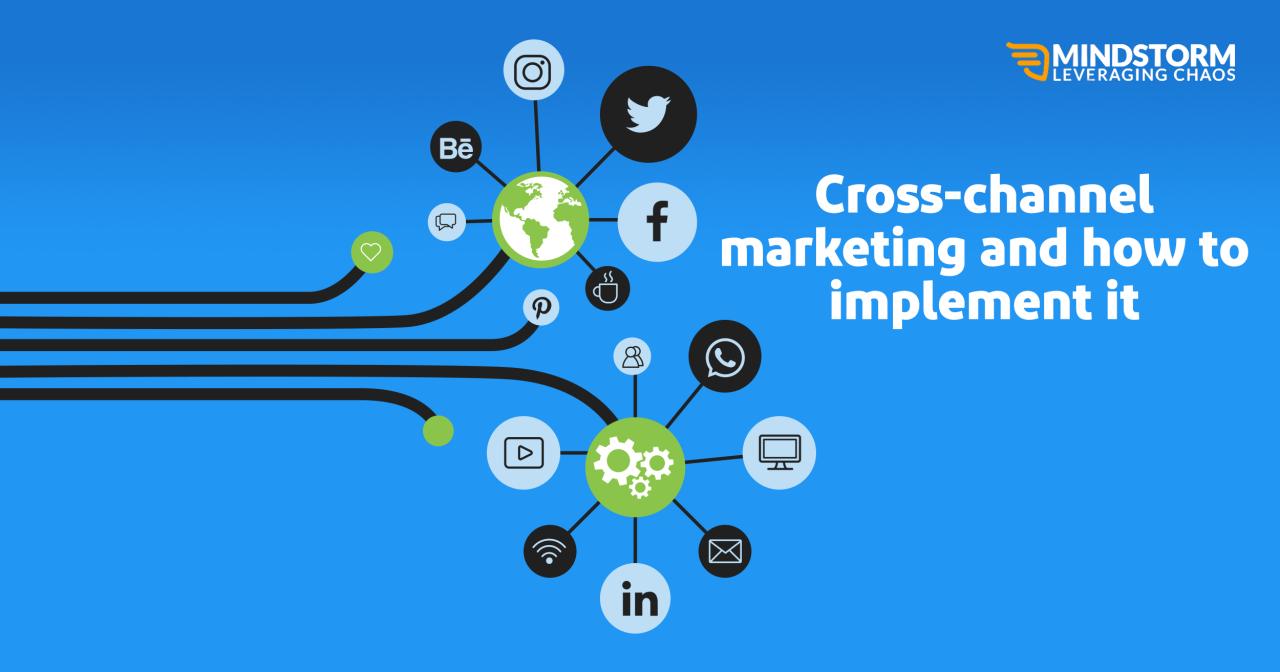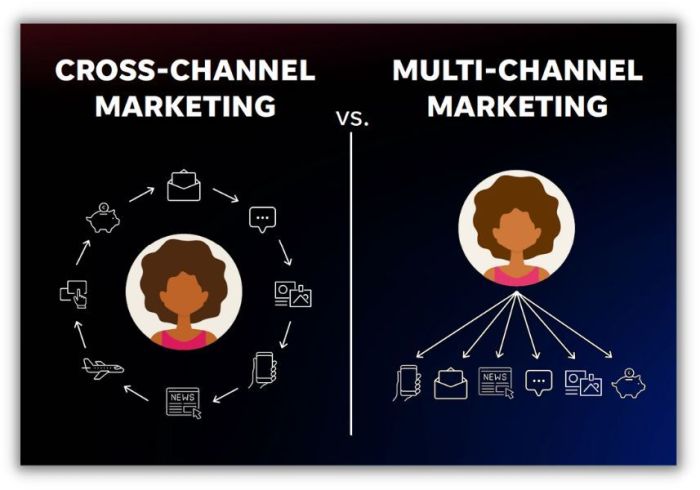Diving into Understanding Cross-Channel Marketing, get ready to explore the dynamic world of brand promotion through various channels. From social media to email campaigns, this overview will equip you with the knowledge needed to ace your marketing game.
Get ready to unlock the secrets of successful cross-channel marketing strategies and elevate your brand’s visibility across platforms.
Definition of Cross-Channel Marketing

Cross-channel marketing is a strategy that involves using multiple channels to reach customers and provide a seamless experience across all platforms. Unlike single-channel marketing, which focuses on one channel like email or social media, cross-channel marketing integrates various channels such as email, social media, mobile apps, websites, and more to engage with customers at different touchpoints.
Examples of Cross-Channel Marketing Campaigns
- Starbucks: Starbucks utilizes a cross-channel approach by allowing customers to earn rewards through their app, website, and in-store purchases. This seamless integration encourages customer loyalty and engagement across multiple channels.
- Nike: Nike’s “Just Do It” campaign spans across social media, TV commercials, and in-store promotions, creating a consistent brand message that resonates with consumers no matter where they interact with the brand.
- Amazon: Amazon’s personalized recommendations and targeted email campaigns create a cohesive experience for customers as they move from the website to their mobile app to receive tailored product suggestions.
The Importance of Integrating Multiple Channels
Cross-channel marketing is essential for businesses to create a unified brand experience and connect with customers on their preferred platforms. By integrating multiple channels, businesses can increase brand visibility, improve customer engagement, and drive conversions by delivering consistent messaging and personalized experiences across all touchpoints.
Benefits of Cross-Channel Marketing
Cross-channel marketing offers numerous advantages for businesses looking to reach their target audience effectively and boost their sales. By utilizing multiple channels to interact with customers, companies can create a seamless experience that enhances customer engagement and drives conversions.
Improved Customer Engagement, Understanding Cross-Channel Marketing
Cross-channel marketing allows businesses to connect with customers on various platforms, such as social media, email, websites, and mobile apps. This multi-channel approach enables companies to reach customers at different touchpoints in their buyer journey, increasing brand visibility and fostering stronger relationships. By delivering consistent messaging across channels, businesses can engage customers more effectively and build brand loyalty.
Higher Conversion Rates and ROI
When businesses implement cross-channel marketing strategies, they can increase their conversion rates and ultimately improve their return on investment (ROI). By targeting customers through different channels and providing personalized experiences, companies can drive more conversions and sales. This integrated approach also allows businesses to track customer interactions across channels, enabling them to optimize their marketing efforts for better results. As a result, businesses can achieve a higher ROI and maximize the impact of their marketing campaigns.
Strategies for Implementing Cross-Channel Marketing: Understanding Cross-Channel Marketing
Implementing a successful cross-channel marketing strategy requires careful planning and execution to ensure consistency and effectiveness across all channels. Here are some key steps to consider:
Creating a Successful Cross-Channel Marketing Strategy
- Identify Target Audience: Define your target audience across different channels to tailor your messaging effectively.
- Consistent Messaging: Ensure that your brand messaging is consistent across all channels to maintain a cohesive brand image.
- Integrated Data: Integrate data from various channels to gain insights into customer behavior and preferences.
- Personalization: Use customer data to personalize content and offers for a more engaging customer experience.
- Automation: Implement marketing automation tools to streamline processes and deliver messages at the right time on each channel.
Tracking and Measuring Performance of Cross-Channel Campaigns
- Set Clear Goals: Establish specific goals for each channel and campaign to track performance effectively.
- Use Analytics Tools: Utilize analytics tools to track key performance indicators (KPIs) and measure the success of your campaigns.
- A/B Testing: Conduct A/B testing to optimize your campaigns and identify what works best for your target audience.
- ROI Analysis: Measure the return on investment (ROI) for each channel to determine the effectiveness of your marketing efforts.
Aligning Messaging and Branding Across Different Channels
- Create Brand Guidelines: Develop brand guidelines that Artikel messaging, tone, and visual elements to ensure consistency across all channels.
- Train Your Team: Provide training to your marketing team to ensure they understand and follow the brand guidelines when creating content for different channels.
- Monitor Feedback: Monitor customer feedback and adjust your messaging and branding strategies based on customer responses to maintain relevance and engagement.
- Regular Audits: Conduct regular audits of your cross-channel marketing efforts to identify any inconsistencies and make necessary adjustments.
Challenges in Cross-Channel Marketing

Implementing cross-channel marketing can come with its fair share of challenges. One common obstacle faced by marketers is the difficulty in integrating various channels seamlessly. It can be a struggle to ensure that the message and branding remain consistent across all platforms. Another challenge is the need for data synchronization and maintaining consistency across channels. Without proper synchronization, the customer experience may be fragmented, leading to confusion and frustration.
Overcoming Integration Challenges
- Establish a centralized management system: Having a centralized platform that can oversee all channels can help in ensuring a cohesive strategy.
- Invest in technology: Utilize marketing automation tools that can streamline processes and enable better integration between channels.
- Regular communication: Foster open communication between teams working on different channels to align strategies and maintain consistency.
Addressing Data Synchronization
- Implement a unified customer data platform: By centralizing customer data, you can ensure consistency and accuracy across all channels.
- Regularly audit data sources: Conduct regular audits of data sources to identify discrepancies and address them promptly.
- Utilize data analytics: Leverage data analytics tools to gain insights into customer behavior and preferences, allowing for more targeted and effective cross-channel campaigns.